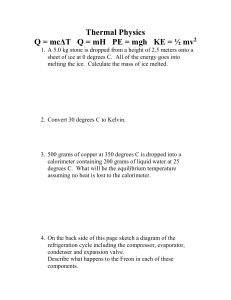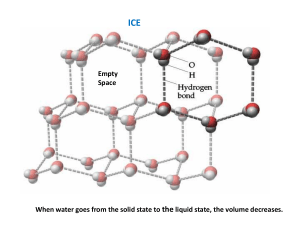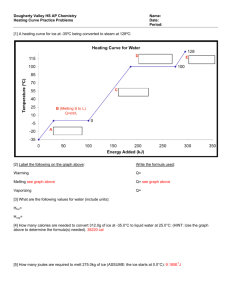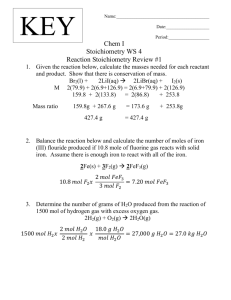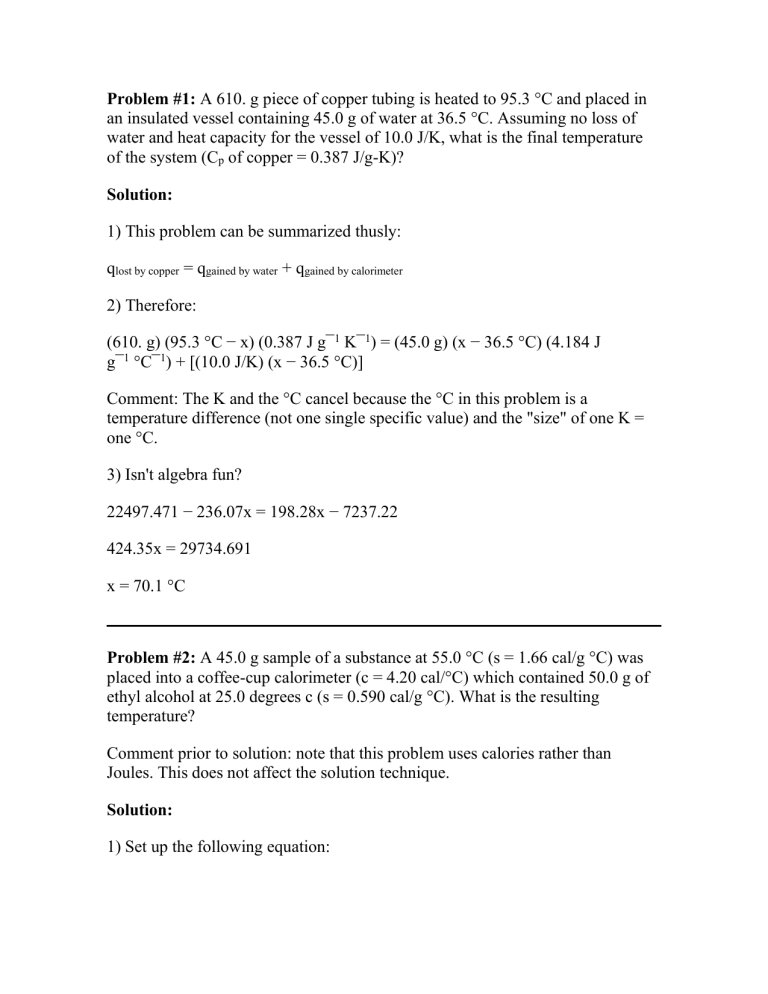
Problem #1: A 610. g piece of copper tubing is heated to 95.3 °C and placed in an insulated vessel containing 45.0 g of water at 36.5 °C. Assuming no loss of water and heat capacity for the vessel of 10.0 J/K, what is the final temperature of the system (Cp of copper = 0.387 J/g-K)? Solution: 1) This problem can be summarized thusly: qlost by copper = qgained by water + qgained by calorimeter 2) Therefore: (610. g) (95.3 °C − x) (0.387 J g¯1 K¯1) = (45.0 g) (x − 36.5 °C) (4.184 J g¯1 °C¯1) + [(10.0 J/K) (x − 36.5 °C)] Comment: The K and the °C cancel because the °C in this problem is a temperature difference (not one single specific value) and the "size" of one K = one °C. 3) Isn't algebra fun? 22497.471 − 236.07x = 198.28x − 7237.22 424.35x = 29734.691 x = 70.1 °C Problem #2: A 45.0 g sample of a substance at 55.0 °C (s = 1.66 cal/g °C) was placed into a coffee-cup calorimeter (c = 4.20 cal/°C) which contained 50.0 g of ethyl alcohol at 25.0 degrees c (s = 0.590 cal/g °C). What is the resulting temperature? Comment prior to solution: note that this problem uses calories rather than Joules. This does not affect the solution technique. Solution: 1) Set up the following equation: (mass substance) (Δt substance) (Cp substance) = (mass alcohol) (Δt alcohol) (Cp alcohol) + (calorimeter constant) (Δt alcohol) There is an implicit assumption that the alcohol and the calorimeter start at the same temperature. This is a very safe assumption. 2) Insert appropriate values: (45.0 g) (55.0 − x) (1.66 cal/g °C) = (50.0 g) (x − 25.0) (0.590 cal/g °C) + (4.20 cal/°C) (x − 25.0) 3) Algebra ensues: 4108.5 − 74.7x = 29.5x − 737.5 + 4.2x − 105 x = 45.7 °C Problem #3: A pure gold ring and pure silver ring have a total mass of 17.0 g. The two rings are heated to 65.4 °C and dropped into 12.4 mL of water at 22.3 °C. When equilibrium is reached, the temperature of the water is 24.7 °C. What is the mass of the gold ring? Solution: 1) Set up the following equation: (mass gold) (Δt gold) (Cp gold) + (mass silver) (Δt silver) (Cp silver) = (mass water) (Δt water) (Cp water) 2) Insert appropriate values: (x) (40.7 °C) (0.129 J g¯1 °C¯1) + (17.0 g − x) (40.7 °C) (0.237 J g¯1 °C¯1) = (12.4 g) (2.4 °C) (4.184 J g¯1 °C¯1) 3) Algebra: x = 8.98 g 4) Comments: a) I looked up the values for the specific heats of gold and silver online. By the way, you should have memorized the sprecific heat value for liquid water by now. b) The terms for the masses of the gold and silver rings comes from the fact that their sum is 17.0 g. We assign 'x' to be the mass of the gold ring, therefore the mass of the silver ring is 17.0 minus x. Problem #4: A 5.00 g sample of aluminum (specific heat capacity = 0.89 J g¯1 °C¯1) and a 10.00 g sample of iron (specific heat capacity = 0.45 J g¯ 1 °C¯1) are heated to 100.0 °C. The mixture of hot iron and aluminum is then dropped into 91.9 g of water at 23.7 °C. Calculate the final temperature of the metal and water mixture, assuming no heat loss to the surroundings. Solution: 1) Set this up: qAl + qFe = qwater (5.00 g) (100 °C − x) (0.89 J g¯1 °C¯1) + (10.00 g) (100 °C − x) (0.45 J g¯1 °C¯1) = (91.9 g) (x − 23.7 °C) (4.184 J g¯1 °C¯1) 2) Let's do some algebra (and drop all the units): (445 − 4.45x) + (450 − 4.5x) = 384.5096x − 9112.87752 393.4596x = 10007.87752 x = 25.4 °C Problem #5: A 50.6 g sample of iron metal is heated and put into 104.0 g of water at 19.7 °C in a calorimeter. If the final temperature of the iron sample and the water is 24.3 °C, what was the temperature of the iron sample when it was placed in the water? Solution: 1) heat lost by iron = heat gained by water: (mass iron) (Δt iron) (Cp iron) = (mass water) (Δt water) (Cp water) (50.6 g) (x − 24.3 °C) (0.450 J/g °C) = (104.0 g) (4.6 °C) (4.184 J/g °C) The 4.6 came from 24.3 minus 19.7. The x − 24.3 °C is the Δt of the iron. It went from a hot temperature 'x' to a cooler temperature of 24.3 °C. 2) Solve for x: (50.6x − 1229.58) (0.450) = 2001.6256 22.77x − 553.311 = 2001.6256 22.77x = 2554.9366 x = 112.2 °C Problem #6: A 505.0 g piece of copper tubing is heated to 99.9 °C and placed in an insulated vessel containing 59.8 g of water at 24.8 °C. Assuming no loss of water and a heat capacity for the vessel of 10.0 J/K, what is the final temperature of the system? (Cp of copper = 0.387 J/g K) Solution: No solution is provided. Please note that K and °C will cancel in the problem. This is because (a) the temperatures in the actual calclation are differences between two temperature values and (b) the "size" of 1 K equals the "size" of 1 °C. Problem #7: What volume of 18.5 °C water must be added, together with a 1.23kg piece of iron (Cp = 0.449 J/g degrees C) at 68.5 °C in an insultated container, so that the final temperature of the water/metal mix remains constant at 25.6 °C? Solution: heat lost by the metal = heat gained by the water (1230 g) (42.9 °C) (0.449 J/g °C) = (mass) (4.184 J/g °C) (7.1 °C) mass = 797.562 grams rounding to 3 sig figs seems reasonable 798 mL Problem #8: A 2.00 x 102 g brass block at 85.0 °C is placed in a plastic foam cup containing 2.00 x 102 g of water at 50.0 °C. No heat is lost to the cup or the surroundings. Find the final temperature of the mixture. Solution: The solution to this problem requires the specific heat of brass. Use this site to find the value. The solution is left to the reader. Problem #9: For two identical blocks, Tf is the average of the initial temperatures, so that Tf = 1/2 (T1 + T2). Show, for a system of two blocks totally isolated from the surroundings, that this is true. (Hint: since the blocks are of the same material, they will have the same Cp.) Solution: I will use T1 for the initial temperature of the warm block and T2 for the initial temperature of the cold block. heat lost by warm block = heat gained by cold block (mass) (ΔTwarm) (Cp) = (mass) (ΔTcold) (Cp) for identical blocks, mass = mass and Cp = Cp; therefore: ΔTwarm = ΔTcold T1 − Tf = Tf − T2 2Tf = T1 + T2 Tf = 1/2 (T1 + T2) Problem #10: 50.0 g of copper at 200.0 °C is placed in ice at 0.0 °C. How many grams of ice will melt? Solution: 1) The copper will go down in temperature to zero Celsius, liberating a certain amount of heat: (50.0 g) (200.0 °C) (0.385 J / g °C) = 3850 J 2) All of the heat from the copper melts ice: (334.16 J/g) (x) = 3850 J x = 11.5 g (to three sig figs) Problem #11: Suppose that 0.82 g of water condenses on a 75.0 g block of iron that is initially at 24.0 °C.? If the heat released during condensation goes only to warming the iron block, what is the final temperature (in °C) of the iron block? Solution: (0.82 g / 18.01532 g/mol) (40.7 kJ/mol) = 1.8525673 kJ = 1852.5673 J lost by the water In order to continue the calculation, you need to know the specific heat of iron. This source says 0.444 J/g °C. 1852.5673 J = (75.0 g) (x) (0.444 J/g °C) x = 55.6 °C change 24.0 °C + 55.6 °C = 79.6 °C Problem #12: 400.0 g of iron is heated in a flame and then dropped into a beaker containing 1.00 kg of water. The original temperature of the water was 20.0 °C, and the final temperature of the water and the iron was 32.8 °C after thermal equilibrium has been attained. What was the original temperature of the hot iron bar? (Assume no heat was lost to the beaker or surrounding air.) Solution: qiron = qwater (400.0 g) (x − 32.8 °C) (0.444 J/g °C) = (1000 g) (12.8 °C) (4.184 J/g °C) 177.6x − 5825.28 = 53555.2 x = 334.35 °C To three sig figs, 334 °C Problem #13: A metal sample weighing 30.66 g is at a temperature of 81.0 °C when it is placed in a styrofoam cup containing 40.0 g of water at 23.0 °C. The temperature of water rose to 25.0 °C. Heat compacity of the cup is 42 J/ °C (a) How many joules did the metal lose to the water? (b) What is the specific heat of the metal? (c) What is the atomic mass of the metal? (d) What metal is it? Solution: q = [(40.0 g) (2.0 °C) (4.184 J/g °C)] + [(42 J/°C) (2.0 °C)] = 418.72 J (answer to a) 418.72 J = (30.66 g) (56.0 °C) (x) x = 0.244 J/g °C) (answer to b) Use Dulong-Petit Law for atomic mass: (specific heat) times (atomic mass) = 3R (0.244 J/g °C) (x) = (3) (8.31447 J/K mol) x = 102.2 g/mol (answer to c) Note: the °C and the K cancel because the "size" of each temperature unit is the same, 1 °C = 1 K. Rhodium is the closest at 102.9 g/mol (answer to d) Looking up the specific heat for Rh, I found 0.242 J/g C. Here is a Yahoo Answers question about the D-P law (note that it is an approximate law). Problem #14: An impure sample of zinc has a mass of 7.35 g. The sample reacts with 150.00 g of dilute hydrochloric acid inside a calorimeter. The mass of the calorimeter is 520.57 g and its specific heat is 0.400 J/g °C. When the reaction occurs, the temperature inside the calorimeter rises from 14.5 °C to 29.7 °C. What is the percentage purity of the zinc sample? Comment: we will assume the density of the HCl solution is 1.00 g/mL and that the specific heat of the HCl solution is the same as pure water. Solution: 1) Total energy given off in reaction of zinc with HCl: q = (mass water) (Δt) (Cp water) + (mass calorimeter) (Δt) (Cp calorimeter) q = (150.0 g) (15.2 °C) (4.184 J/g °C) + (370.57 g) (15.2 °C) (0.400 J/(g °C)) q = 9539.52 + 2253.0656 = 11792.5856 J Note: the 370.57 comes from 520.57 minus 150.00 2) We now need to see how much zinc puts out the above amount of heat. For that, we need the enthalpy of this reaction: Zn(s) + 2HCl(aq) ---> ZnCl2(aq) + H2(g) Some Internet searching (see problem 5.66) leads to a value of -152.4 kJ per mole of Zn. This calculation: 11792.5856 J divided by 152400 J/mol = 0.07738 mol of Zn Then, this calculation: 0.07738 mol times 65.409 g/mol = 5.06 g 3) Determine percent zinc in sample: (5.06 g / 7.35 g) times 100 = 68.8% (to three sig figs) Problem #15: A 25.75 g piece of iron and a 28.45 g piece of gold, each at 100.0 °C were dropped into 570.0 mL of water at 17.70 °C . The molar heat capacity of iron and gold are 25.19 J mol¯1 °C¯1 and 25.41 J mol¯1 °C¯1 respectively. What is the final temperature of the water and pieces of metal? Solution: 1) The set up for the problem: total Joules liberated by the iron + total Joules liberated by the gold = total Joules absorbed by the water (25.75 g / 55.845 g/mol) (100.0 − x) (25.19 J/mol °C) + (28.45 g / 196.97 g/mol) (100.0 − x) (25.41 J/mol °C) = (570.00 g) (x − 17.70) (4.184 J/g °C) Solve for x, which is the final temperature. 2) Here are what the several of the terms mean: (25.75 g / 55.845 g/mol) ---> moles of Fe (28.45g / 196.97 g/mol) ---> moles of Au (100.0 − x) ---> temp change of Fe and Au (they each start at 100 °C and go down to the final temperature, symbolized by 'x') (x − 17.70) ---> temp change of water Note that the specific heat for water is gram-based while the Fe and Au are molebased. This is OK since I use moles of Fe and Au (to cancel with the mol in the Fe and in the Au specific heats) and I use grams of water (to cancel with the grams in the specific heat value for water). Every unit will cancel properly. Problem #16: Calculate the number of grams of ice that will melt, if 1000.0 g of iron at 500.0 °C is dropped into an ice-water mixture. The heat of fusion of water is 334.166 J/g. Specific heat for iron = 0.448 J/g °C. Assume that there is enough ice such that some is left after thermal equilibrium is achieved. Solution: The last sentence is critical because it ensures that there is no temperature change, only ice will melt and the entire system stays at zero Celsius. 1) Determine energy liberated by the iron: q = (mass ) (temperature change) specific heat) q = (1000.0 g) (500.0 °C) (0.448 J/g °C) q = 224000 J The fact that some ice remains allows us to know definitively that the iron will drop from 500.0 °C to 0 °C. 2) Determine the ice that will melt: 224000 J divided by 334.166 J/g = 670.3 g 3) This problem could have been solve thusly: (1000.0 g) (500.0 °C) (0.448 J/g °C) = x / 334.166 J/g The assumption here is that 100% of the energy lost by the iron goes to melt ice. Problem #17: 18.0 mL of water at 28.0 °C are added to a hot skillet. All of the water is converted to steam at 100.0 °C. The mass of the pan is 1.25 kg and the molar heat capacity of iron is 25.19 J/mol °C. What is the temperature change of the skillet? Solution: 1) Determine the energy need to heat and boil the water: heat: q = (18.0 g) (72.0 °C) (4.184 J/g °C) = 5422.464 J = 5.422464 kJ boil: q = (40.7 kJ/mol) (18.0 g / 18.0 g/mol) = 40.7 kJ total: 40.7 kJ + 5.422464 kJ = 46.122464 kJ I won't bother to round off until the final answer. 2) Determine temperature change of skillet: 46122.464 J = (22.38338 mol) (Δt) (25.19 J/mol °C) Δt = 81.8 °C Note that moles of iron are used rather than grams. This is because of the units on the specific heat provided in the problem. Problem #18: A ball of copper has a mass of 125 grams and is at a temperature of 145 °C. This ball is placed into a calorimeter which contains 25.0 grams of ice at −35.0 °C. What will be the final temperature of the copper ball? (specific heat of copper = 0.387 J/g °C) Solution: The copper ball will lose heat to the ice. All of the ice will first heat to 0 °C, then it will start to melt. As the ice melts, a liquid-ice system is created which remains at 0 °C. If the copper melts all the ice, only then will the liquid water move from zero °C up to some final, equilibrium temperature with the copper 1) Let's heat the ice up from −35 °C to 0 °C and see how much energy that takes. q = (25 g) (35 °C) (2.06 J/g °C) <--- note the use of water's specific heat as a solid q = 1802.5 J 2) Let's see what happens to the copper's temp when 1802.5 J are removed. 1802.5 J = (125 g) (x) (0.387 J/g °C) x = 37.26 °C 145 − 37.26 = 107.74 °C <--- copper ball cooled to this temp. 3) Now, let's cool the copper ball all the way down to zero and see how much energy is liberated by that. q = (125) (107.74) (0.387) = 5211.9225 J 4) Next, we need to figure out how much ice melted using 5211.9225 J of energy. 5211.9225 J = (x) (6020 J/mol) <--- that's the molar heat of fusion for water x = 0.86577 mol 0.86577 mol times 18.015 g/mol = 15.6 g Since we had 25 g of ice to start with, melting 15.6 g of ice leaves some ice still in the system. Since all the ice has to melt before we can move off 0 °C, we conclude that the entire system of liquid-ice-copper is at 0 °C when equilibrium is reached. Problem #19: A copper cube with a mass of 100 grams is heated in a boiling water bath to 100.0 Celsius. The cube is removed from the bath and placed on a very large block of ice which is at a temperature of 0.00 Celsius. What is the maximum mass of ice that could conceivably be melted by the heat exchange, assuming all the thermal energy is used to melt the ice? Solution: 1) Let's determine how much energy was released by the copper as it melted some ice: q = (mass) (Δt) (spec. heat) q = (100.0 g) (100.0 °C) (0.385 J/g °C) q = 3850 J 2) Now, we determine how much ice can be melted: q = (mass) (heat of fusion) 3850 J = (334.166 J/g) (x) x = 17.25 g to three sig figs, 17.2 g (using the rule for rounding with five) 3) Comments: (a) the specific heat for copper can be looked up in a textbook or on the Internet. (b) the heat of fusion can be looked up (or calculated from the molar heat of fusion, 6.02 kJ/mol) Problem #20: A 12.0 g piece of aluminum at 22.0 °C is placed in 175.0 mL of water at 85.0 °C and allowed to come to thermal equilibrium. What will the final temperature be? (Other factors, such as heat transfer to the air, should be ignored.) The specific heat of aluminum is 0.215 cal/g °C. Solution: 1) Before starting the solution, can you spot the mistake in this proposed solution (and it's not that there are no units on anything)? (175.0) (4.184) (85.0 − T) = (12) (0.215) (T − 22.0) The mistake is in the improper mixing of units. 4.184 is the specific heat of liquid water in J g¯1 °C¯1 and 0.215 is the specific heat of aluminum in cal g¯1 °C¯1. You can't have those two specific heat units in the same problem and be correct. The units must match up, so both specific heats have to be in J g¯1 °C¯1 or both have to be in cal g¯1 °C¯1. You can't have one be in one unit and the other be in the other unit and still be correct. The original question on Yahoo Answers had some multiple choice answers and one of them was the answer obtained when you make the above mistake. 2) The correct set up (and solution) using calories: (175.0) (1.00) (85.0 − T) = (12) (0.215) (T − 22.0) 14875 − 175T = 2.58T − 56.76 14818.24 = 177.58T T = 83.4 °C The solution in J g¯1 °C¯1 is left to the reader.
